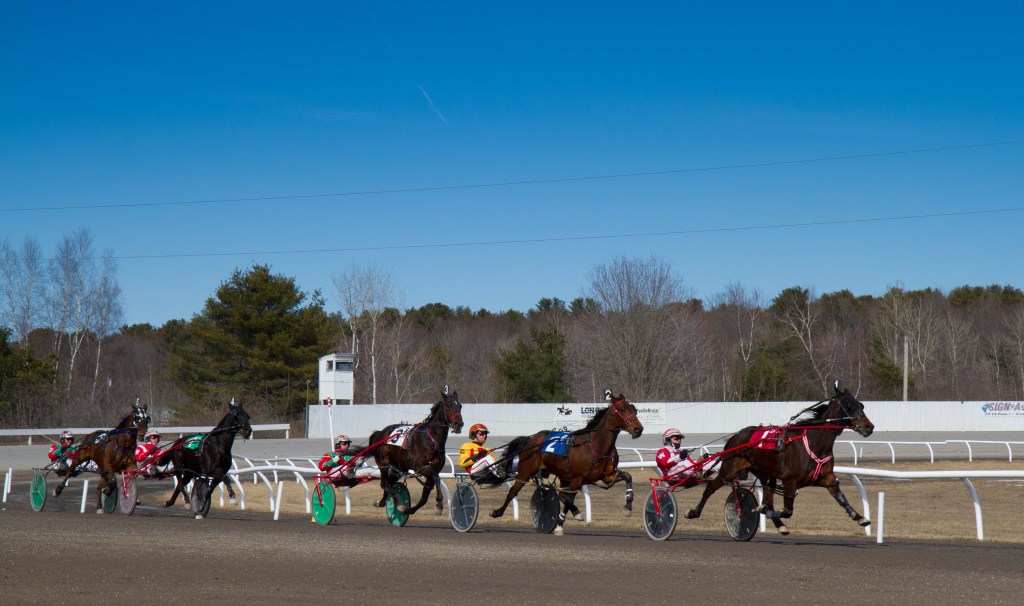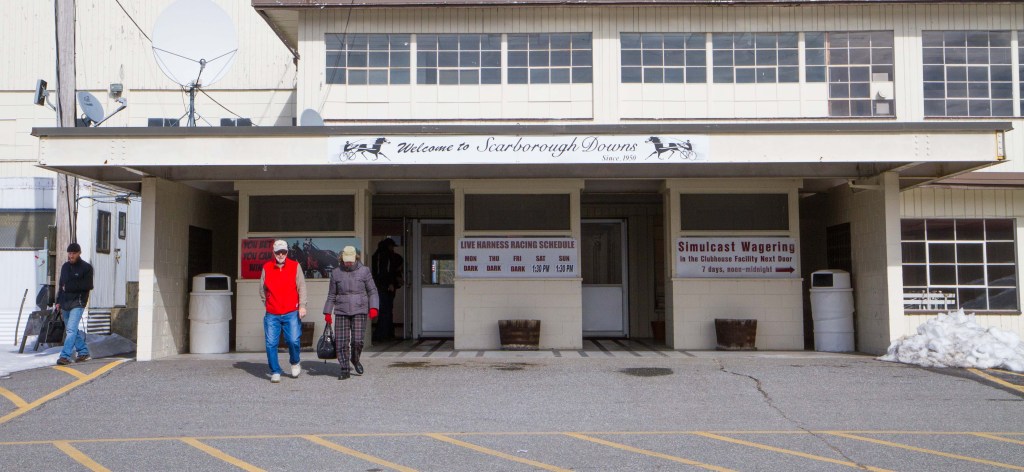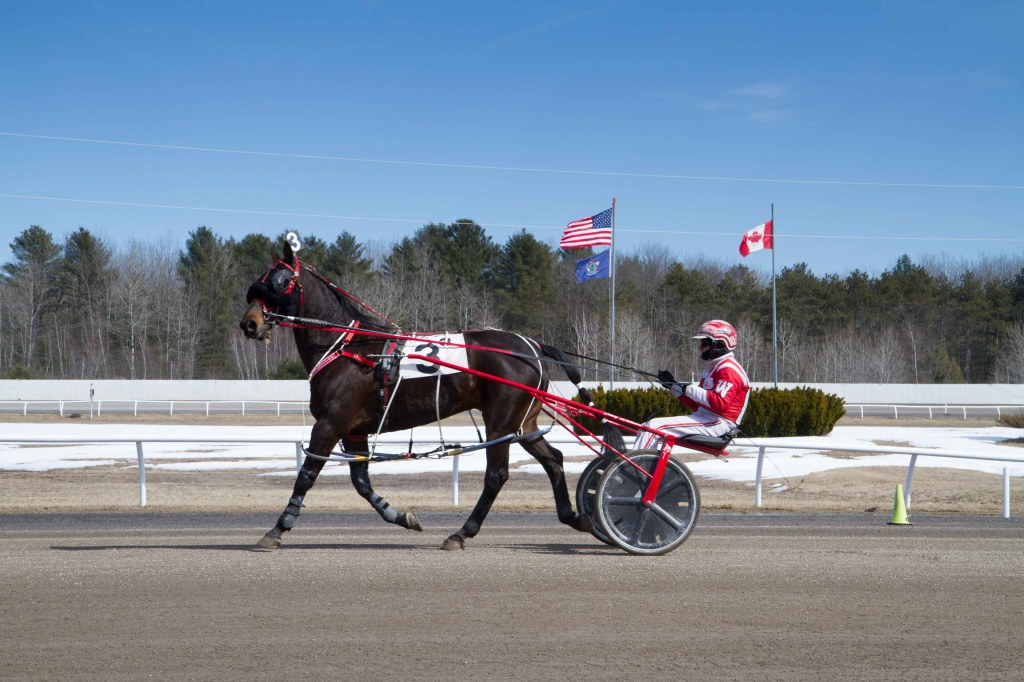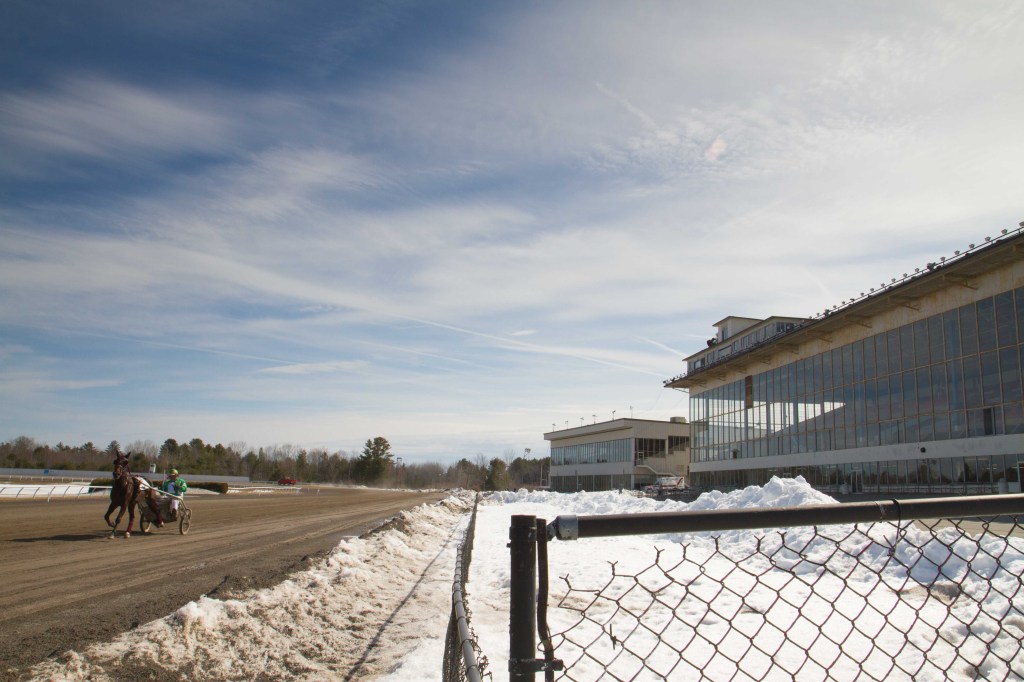SCARBOROUGH — Horse racing fan Craig Varney had driven more than 100 miles from his home in Waldo to watch the opening day of Maine’s harness racing season at Scarborough Downs in late March.
When he arrived, things didn’t look good.
Plow trucks had pushed head-high mounds of dirty snow against the venue’s dilapidated chain-link fence. Spectators watched the races from within their own idling cars and trucks parked on a nearby hillside or else scrambled over the banks. The facility itself — the mainstay of Maine harness racing, which features horses pulling two-wheeled carts and drivers — was downtrodden and cold, with peeling paint, water-stained ceiling panels, broken windowpanes and bathroom doors that didn’t close.
Looming over the dismal scene was the prior day’s news: The track, situated on 500 acres of prime real estate in Scarborough, was under contract with a real estate developer from Massachusetts. Though Scarborough Downs has received an estimated $13 million in state subsidies over the past 12 years, there is no requirement that the new owner continue to operate the property as a racetrack. “If Scarborough goes, this industry has had it,” Varney said.
The fate of Scarborough Downs serves as a cautionary tale of what happens when the state subsidizes an industry but fails to set firm goals and ensure accountability, a Pine Tree Watch investigation has found. Since 2005, the state has routed $112 million from the casinos in Bangor and Oxford to the harness racing industry — an average of $9.3 million going to the industry each year. But the financial windfall, the result of a political bargain struck after voters in 2003 authorized slot machines at the state’s commercial racetracks, has done little to shore up the ailing sport of harness racing.
With promoters of a proposed southern Maine casino promising yet more revenue for horse racing, the investigation suggests a new infusion of cash would amount to little more than throwing good money after bad. Among the findings:
• Reports from regulators warn of an industry on the “brink of viability.” Since 2003, the number of licensed horse owners has fallen by 40 percent, betting on horse racing has dropped by 57 percent and the number of mares bred is down 44 percent, even as the state has subsidized racing prizes, venues, off-track betting parlors and breeding programs.
• Lawmakers shoulder some of the blame: Legislation passed in 2004 gave little guidance for how the funds were to be used and asked for little in return. Commercial racetracks and off-track betting parlors, for example, provide no receipts and little after-the-fact accounting for how they spend racino funds.
• As interest in horse-racing falters and expenses rise, the industry is increasingly dependent on a handful of wealthy owners. In 2015, the top ten competitors in Sire Stakes races, which promote breeding of horses in Maine, netted $1.11 million in state-subsidized purses, or prize money — more than the combined total of the remaining 69.
• Allegations of horse drugging spiked to ‘unprecedented’ levels in 2015. While prosecutions declined in 2016, the bad publicity severely damaged public perception of horse racing, resulting in a “credibility problem” and further discouraging investment in the industry, according to internal surveys and reports.
Increasingly, the industry’s solution to its problems has been to push for legislation to authorize more racinos and receive yet more subsidies. In a 2016 survey of horse owners and breeders — among the state’s most avid horse racing participants — respondents ranked “Fear of legislature taking our money” among their top concerns.
Proponents say the dire statistics don’t tell the full story and argue that the dollars transferred from the racino and casino revenues help save a flagging Maine tradition and bolster the agricultural economy in rural areas.
“It’s a tradeoff,” said Henry Jennings, director of the state’s Harness Racing Commission. “We’re spending money, but we’re helping to maintain an agricultural way of life and a little more open space in parts of the state where it’s disappearing the fastest.”
HORSE RACING HITS JACKPOT
The 2003 referendum was supposed to change everything for the harness racing industry.
That year, Las Vegas casino developer Shawn Scott made big promises when he brought his citizen-initiated legislation to Maine voters: Authorize slot machines at commercial horse racing tracks in Maine, and the proceeds would help save the ailing harness industry.

Rep. Don Marean, R-Hollis
Rep. Don Marean (R-Hollis), the industry’s most ardent advocate in the Maine Legislature and a horse owner himself, recalls the campaign. “Scott had the dough. But we had the energy,” said Marean. “We were everywhere with horses and people and trailers.”
The horsemen came out in droves to support the so-called ‘racino’ referendum: They made videos, TV advertisements, radio spots, appeared at the State House and at legislative hearings — sometimes in full racing garb alongside the muscular and charismatic horses that are the hallmark of their sport.
The hard work paid off; the referendum passed. Scott had promised 11 percent of net slot machine revenues to harness racing and agricultural fairs, in addition to funds for college scholarships and prescription drugs for the elderly. But by April 2004, the industry and its lobbyists had negotiated a much sweeter deal for fans of harness racing, according to Pine Tree Watch’s analysis.
The final agreement, negotiated after the referendum passed as part of a measure intended to regulate the fledgling slots industry in Maine, directed 1 percent of gross slot revenues to beefing up enforcement of gambling rules. But it also went one step further, dedicating 22 percent of net revenues — double the percentage initially approved by voters — to the harness racing industry, a review of legislative records show. The percentage of revenues going to prescription drugs and scholarships, meanwhile, did not change from the original referendum.
The new arrangement included earmarks that would add up to millions over the course of a decade for every facet of the harness racing industry, from supplementing purse, or prize-money, to special funds to support racing at commercial racetracks, betting at off-track gaming parlors, agricultural fairs and even an in-state breeding program for young horses.
For industry advocates like Wendy Ireland, who owns a stable in West Gardiner and has lobbied on behalf of the industry, that money was no handout; it was the rightful conclusion to a hard-fought campaign.
“We were the key moving force in getting that referendum passed,” she said. “If it wasn’t for the harness racing industry, there would be no slots in the first place.”
Marean agrees. “It’s not the state’s money. It’s ours,” he said. “We got that money because we worked for it.”
But as the money started to flow, some lawmakers grew skeptical. In 2010, a bipartisan group of legislators of the Veterans and Legal Affairs Committee, which oversees the racino funds, scrutinized the arrangement, concluding that the original law gave “very little, if any, direction on how to spend the money.” As a result, they wrote, there was “very little information about how that money is spent.”
The lawmakers demanded proof that the money was having the desired effect of shoring up the industry. “There needs to be transparency and accountability among those who receive slot machine revenues so that the impact of these funds can be thoughtfully measured,” the study concluded.
WELFARE INDUSTRY?
Seven years later, legislators are asking the same questions.

Rep. Louie Luchini, D-Ellsworth
On April 5, 2017 — nearly 15 years after the racino referendum — Harness Racing Commission Executive Director Henry Jennings stood before lawmakers, his agency’s annual “Use of Funds” report in hand, struggling to explain exactly how Scarborough Downs and other recipients had spent millions in state funds.
When Rep. Louie Luchini (D-Ellsworth) asked him to clarify two pages of the report, a complex jumble of numbers and horse racing and betting jargon that outline how funds are distributed and spent by the industry, Jennings waffled. “I was hoping you wouldn’t ask me about these two pages,” he said.
Then he reminded the committee that the original legislation didn’t put any restrictions on how certain recipients like Scarborough Downs should use the money.
Lawmakers fumed. “It’s my seventh year on this committee and we see this every year,” said Rep. Thomas Longstaff (D-Waterville). “Too often we come here, and the answer is: ‘Well, we really don’t know how that’s spent.’ Is there any chance that we can get a more precise accounting of how the funds are used?”

Rep. Thomas Longstaff, D-Waterville
Jennings’ reports do make one thing clear, however: The industry has continued to decline despite the subsidies. Since 2003, the number of licensed race horse owners declined by 40 percent, betting at live races by 54 percent, and the number of mares bred for the Sire Stakes program dropped by 44 percent.
The declines are not news to anyone in the industry, said Marean. “The numbers don’t lie,” he said. “We’re in trouble, there’s no question about that.”
But he disagrees that the industry is at fault. The reason for the decline, he said, lies elsewhere: Competition for gambling dollars from the state lottery, out-of-state online wagering, regional casinos and the uncertainty surrounding Scarborough Downs.
But lawmakers at the April meeting chided the industry, saying it had failed to market itself for long-term sustainability, becoming too dependent on the ‘cascade’ of funds that come from the Bangor racino.
“What we’re doing by not advertising… is making this a welfare industry on state funds,” said Rep. Longstaff.

Rep. Kathleen Dillingham, R-Oxford
Rep. Kathleen Dillingham (R-Oxford) said she hoped the industry would present a plan beyond more subsidies from a new casino in southern Maine. “To increase participation in the industry,” she said. “Not necessarily to increase revenue coming from the state.”
Marean dismissed their criticisms as a money grab. “VLA [Veterans and Legal Affairs] is asking questions about things they don’t understand because they don’t know how the industry works,” he said. “It gives them a platform to continue to paint a black picture. What someone is after is the cascade money.”
INDUSTRY WOES, MONEY FLOWS
Despite the industry’s woes and lawmaker scrutiny, the dollars continue to flow unchecked, Pine Tree Watch’s investigation found.
The family-owned Scarborough Downs, for example, has received an estimated $13 million from the Fund to Encourage Racing at Maine’s Commercial Tracks, one of several funds to receive proceeds from the Hollywood Casino in Bangor. The annual subsidy, which has averaged around $1.2 million, is based on the number of days raced and amounts to a blank check: the law says nothing about how the money is to be spent, and requires no after-the-fact auditing.
Regulatory filings show that initially, that money was used for “capital improvements.” Early reports submitted to lawmakers included itemized lists of investments: improvements to the electrical system in the horse barns, a new water truck for the track and updates to the smoking lounge.
But as Scarborough Downs’ business continued to slide, records suggest the venue stopped investing — even as it continued to take in millions in state subsidies. Specific details on how the funds were being used disappeared from reports, according to Pine Tree Watch’s review of regulatory filings.
Representatives of Scarborough Downs did not reply to repeated requests for an interview.
In 2014, Henry Jackson, then director of the state’s Harness Racing Commission, began asking questions at the urging of state lawmakers. In an email obtained by Pine Tree Watch, William Manning, an operations analyst at Scarborough Downs, explained that the state’s premier track was losing approximately $13,200 for each day raced in 2014, or $1,387,018 annually. The money transferred from the state, he wrote, had been used to “offset part of its loss suffered every day it conducts live racing.”
Former industry lobbyist and horse trainer Wendy Ireland said providing funds to an aging racetrack like Scarborough Downs was probably a bad idea. “Looking back, the legislature made a big mistake there, obviously,” she said. “The facility [at Scarborough Downs] is too big for what we really need. It’s a dinosaur and a tough place to maintain. Could they have spent money a little better, and done things better? Absolutely.”
Lawmakers in 2014 asked similar questions of the state’s other commercial racetrack, the Hollywood Casino Hotel and Raceway in Bangor. Michael Hopkins, the manager of live racing there, responded by email in Feb. 19 of that year: “We do not keep any specific breakdowns of how this money is spent, but obviously this is used for operating expenses incurred at the track.”
Hopkins, who continues to manage live racing in Bangor, did not reply to repeated requests for an interview.
Financial reports submitted to the Veterans and Legal Affairs Committee in April, however, stated that both Scarborough and Bangor continue to use the funds “to defray general operating expenses.”
BIG MONEY, SMALL INDUSTRY
Even as the industry has faltered, state subsidies continue to ensure big purses on race day. But the beefed-up prizes — intended to keep racing alive and entice more betting — may not have had the broad benefits that lawmakers intended.
While the number of licensed racehorse owners has declined since the state subsidies began, the number of trainers and stable owners has grown, Pine Tree Watch’s investigation found.
That’s no coincidence, say industry advocates. “There are more trainers now because the purses have come up. There’s more chance of a return on investment,” said Marean.
Prize money for so-called Sire Stakes races, where young, Maine-bred horses compete, for example, has more than doubled, from $770,280 in 2003, the year the referendum passed, to $1.8 million in 2016, a spike largely made possible by state subsidies that industry reports say has made horse owners “extremely happy.”
But records show the money provided by the state — a total of $14.7 million over 11 years — has increasingly been won by a smaller and smaller group of wealthy, and sometimes out-of-state, owners who can still afford to compete in a dying and unprofitable industry.
In 2015, the top ten breeders had netted $1.11 million in state-subsidized purses, more than the combined total of the bottom 69. Commission emails obtained by Pine Tree Watch also show that in 2014 as much as 20 percent of the total subsidy, or $438,000, had gone to out-of-state horse owners, from places like Nevada, Massachusetts, New Jersey and New Brunswick, Canada.
When asked why the number of horses bred in the state had declined, a majority of respondents to a September 2016 internal survey of horse owners conducted by the Maine Standardbred Breeders and Owners Association (MSBOA) mentioned the expense of raising horses and an unwillingness to compete against top breeders.
Industry advocates say critics overlook the fact that the benefits of the Sire Stakes program trickle down to a much larger group.
“The funds go way beyond just the horse owners,” said stable owner Wendy Ireland. “We have 16 horses at our barn. We have a grain guy. A farrier. A veterinarian. There’s the guy that comes to do my horses’ teeth. And hay suppliers. And then there’s the trailer industry. I could go on and on.”
Ireland said several horses at her stable in West Gardiner belong to out-of-state owners yet are trained and raced in Maine; an example, she says, of how the money comes back to Maine even if the owners are from out-of-state.
The Harness Racing Commission does not keep data on how much of the money paid out to out-of-state horse owners returns to Maine. Tim Powers, president of the Maine Harness Horseman’s Association, did not reply to repeated requests for an interview.
But a recent economic study, conducted by the University of Southern Maine, found that the industry as a whole had generated $57.5 million in goods and services in Maine last year, had employed 1,026 people and had helped preserve 7,174 acres of open space.
“People see that there’s a lot of money going to wealthy owners, but they don’t realize how much of it comes back into the economy,” said Ireland.
For lawmakers like Rep. Luchini, chair of the legislative committee that oversees the distribution of casino funds, the benefits must be weighed against other potential uses of public dollars in a state with a notoriously tight budget.
“Yes, there are benefits, there’s no denying that. Whether or not the benefits outweigh the costs is the question,” Luchini said.
Dave Sherwood is a staff reporter for Pine Tree Watch, a nonpartisan, nonprofit investigative news service focused on Maine state government and institutions. Email: dave@pinetreewatch.org.
Copy the Story LinkSend questions/comments to the editors.






Success. Please wait for the page to reload. If the page does not reload within 5 seconds, please refresh the page.
Enter your email and password to access comments.
Hi, to comment on stories you must . This profile is in addition to your subscription and website login.
Already have a commenting profile? .
Invalid username/password.
Please check your email to confirm and complete your registration.
Only subscribers are eligible to post comments. Please subscribe or login first for digital access. Here’s why.
Use the form below to reset your password. When you've submitted your account email, we will send an email with a reset code.